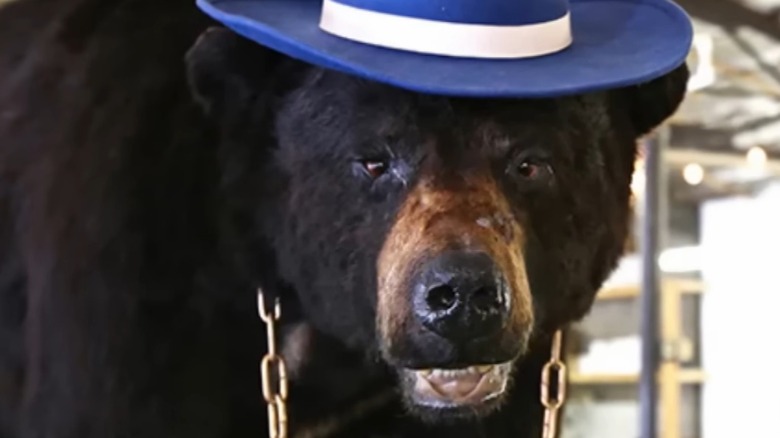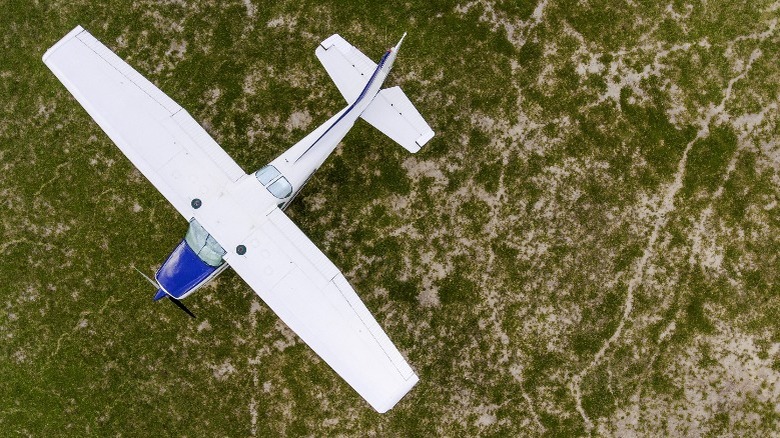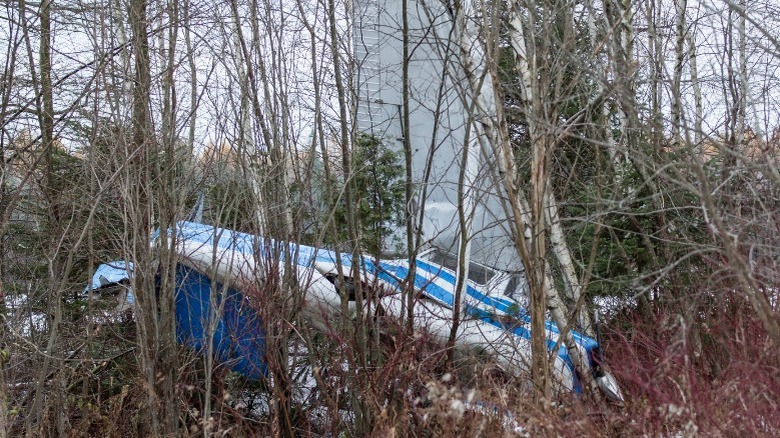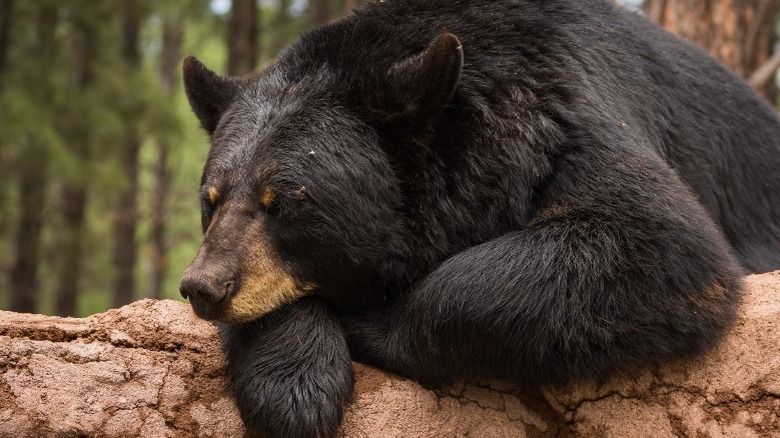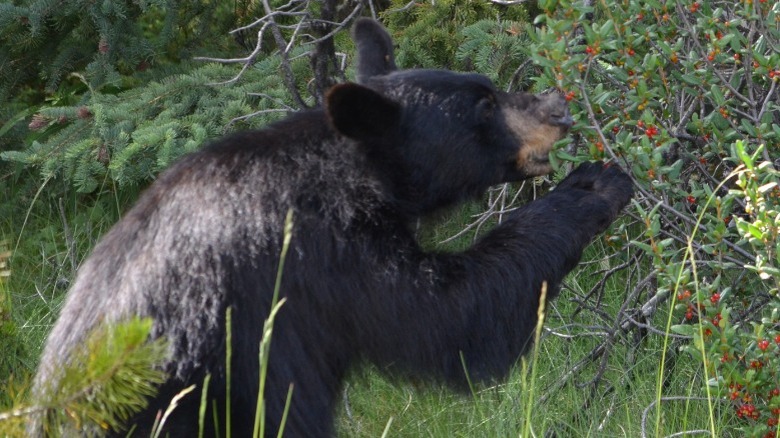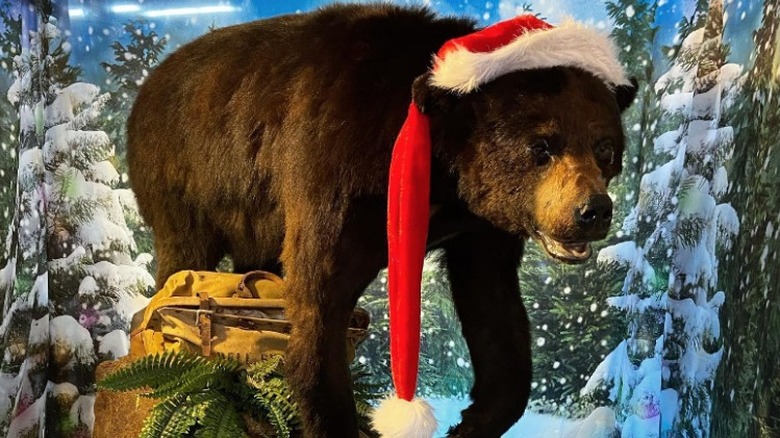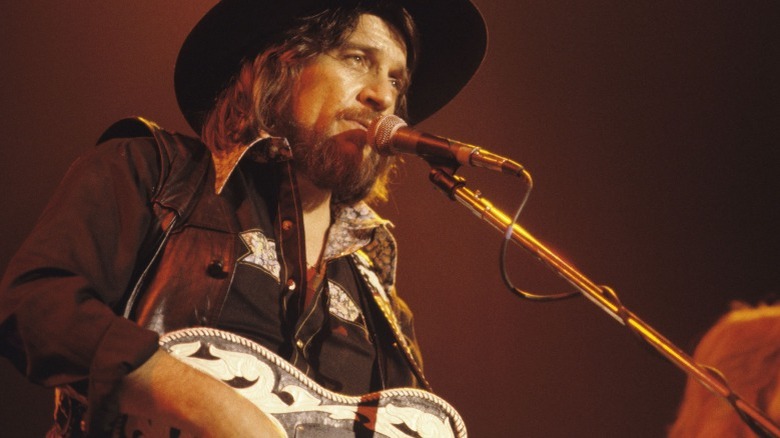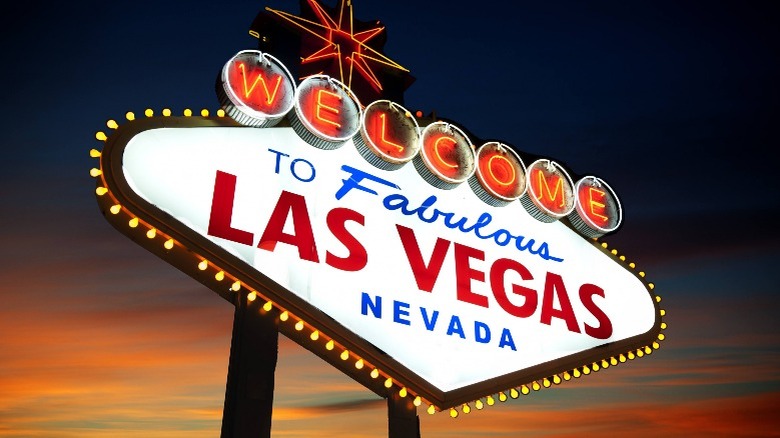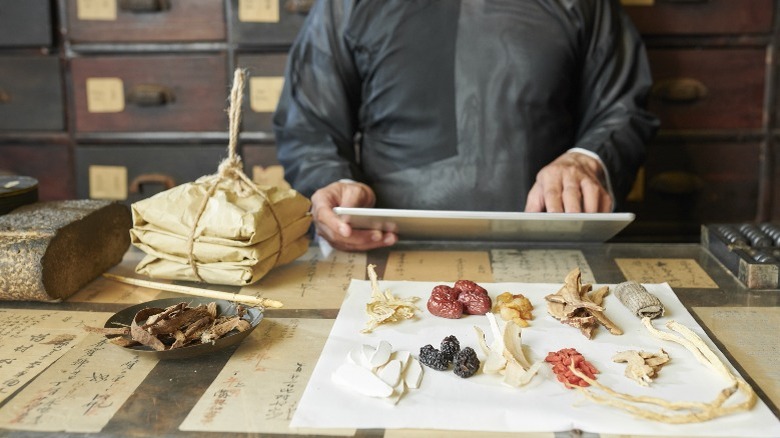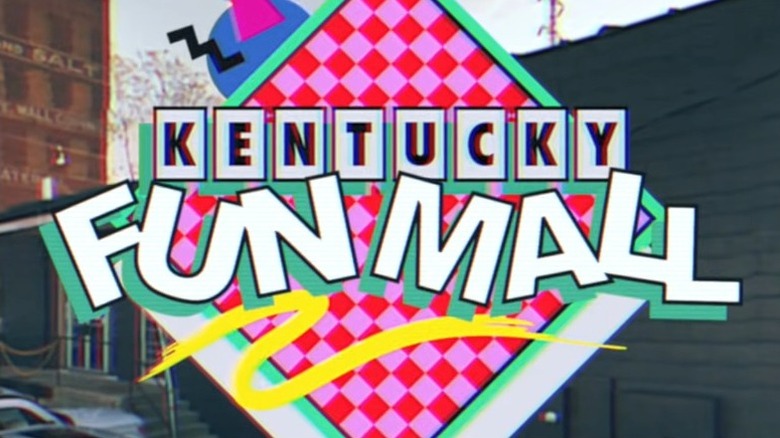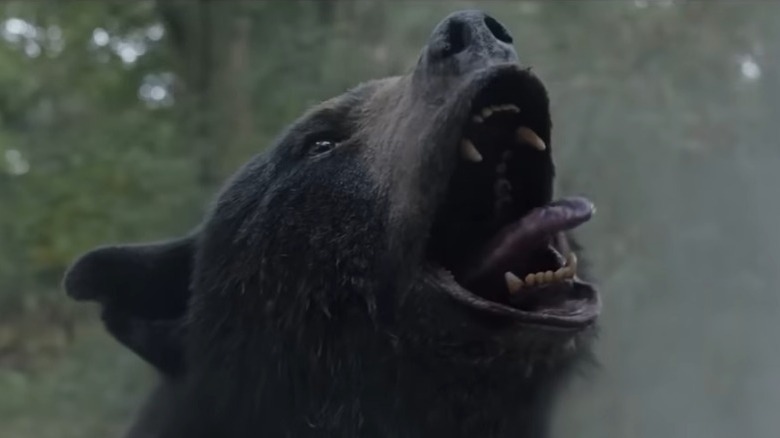The Incredible Story Of Kentucky's Cocaine Bear
It really doesn't get much wilder than the tale of Cocaine Bear – also known as Pablo Eskobear – a hapless American black bear who stumbled upon some powerful Columbian nose candy deep in a Georgia forest in 1985, overdosed, and now lives on forever in taxidermized infamy (per The Washington Post). It's a situation that naturally raises many questions. How did millions of dollars worth of cocaine end up abandoned in an Appalachian forest? Why would a bear eat it? And, most importantly, how is there enough to this story to merit a full feature-length article?
Answering these questions first requires an exploration of the bizarre life of Cocaine Bear's dealer, Andrew C. Thornton II. A privileged rich kid who always hungered for adventure, Thornton's insatiable quest for excitement led him to the military, the police force, and later to a life of full-on crime. It was the latter vocation that gave rise to the outrageous-but-true events that spawned the cultural phenomenon that is Cocaine Bear. From Thornton's doomed final heist to a bear's accidental overdose to the departed creature's riveting second life as a stuffed collectible, legendary figure, and movie inspiration, here is the incredible story of Kentucky's Cocaine Bear.
Andrew C. Thornton II had it all
Andrew C. Thornton II was born into a life of prestige. According to The Washington Post, his parents owned a thoroughbred horse farm in Kentucky, where young Thornton attended a private elementary school. Already drawn to adventure, a teenage Thornton enrolled in Tennessee's Sewanee Military Academy. He graduated in 1962 and continued on to the University of Kentucky, though he soon dropped out to join the Army.
There, Thornton became a skilled paratrooper. He even won a Purple Heart for his service during the U.S. invasion of the Dominican Republic in 1965. Injured, Thornton left the Army and returned to Kentucky, where he briefly worked alongside his father training racehorses before marrying and becoming a police officer. Neither venture would last long. "Andrew could walk the edge only so long before it became routine," a fellow police officer said of Thornton, "He was a 'Starsky & Hutch' type of cop – he drove fast cars, popped in, and raided people."
As the Los Angeles Times notes, Thornton served on the Lexington police force from 1968 to 1977, with three of those years spent on the narcotics squad. He worked closely with the DEA, making drug busts by day and putting himself through law school by night (per The Washington Post). A friend described him to the L.A. Times as "one of the smartest fellows I ever met," adding, "He came from a very good family and had everything in the world going for him."
Thornton's thirst for adventure led him to a life of crime
Eventually, Andrew Thornton's thrill-seeking took him from one side of the law to the other. As his ex-wife Betty Zairing told The Washington Post in 1985, Thornton's career as a narc required frequent involvement with dangerous crime figures, including Mafia hit men. By 1970, Zairing couldn't tolerate Thornton's risky lifestyle anymore and the couple divorced.
As the years went on, Thornton's paranoia about an impending nuclear holocaust increased. He began stockpiling weapons and emergency supplies at his Kentucky farm, which over time became a razor-wire-encircled compound. He also took to dressing in camouflage fatigues and a bulletproof vest, embellishing the ensemble with swastikas. According to local police officers, Thornton's property was under regular surveillance for suspected illegal activities. But things didn't truly escalate until 1977, when he left the police force to join his childhood friend, Bradley Bryant, on a private security venture.
As the Los Angeles Times notes, the venture turned out to be an elaborate drug-smuggling ring called "The Company." When Bryant was arrested in 1981, Thornton was implicated in the activities – including stealing weapons from a naval base and piloting a plane full of marijuana from South America to Kentucky – and ended up serving six months in prison for conspiracy charges. Years later, four of Thornton's former associates who were directly involved in his conviction died suspiciously (per The Washington Post). Police suspected that Thornton had a hand in these "vendetta deaths."
A daredevil cocaine-smuggling operation went awry
A short prison sentence did nothing to deter Andrew Thornton from his mercenary endeavors. As Thornton's unwilling former accomplice Bill Leonard told The Knoxville News Sentinel (via Knox News) in 1990, Thornton had invited Leonard – then his karate instructor and sometimes bodyguard – on a friendly trip to the Bahamas. The pair set off in a Cessna plane on September 9, 1985, curiously joined by a Columbian stranger. Mid-flight, Thornton casually told Leonard that they weren't going to the Bahamas after all.
Instead, the trio landed in a swamp in Montería, Columbia, where they were greeted by several men holding machine guns. There, Leonard helped load the plane with 400 kilograms of cocaine. The kilos – each carefully packaged in yellow plastic – were crammed into burlap sacks and zipped into several parachute-equipped duffel bags. The pair then took off and headed back to the United States, where the plan promptly fell apart.
While they were flying over Florida en route to Kentucky, radio chatter indicated that federal agents had started tracking their plane. Panicked, Leonard kicked a few bags of cocaine out of the plane, and the two engaged in a brief scuffle. Thornton ultimately apologized for involving him in the operation, fastened parachutes to each of them, tossed a few more bags of coke out to lighten the load, and gave Leonard some quick skydiving tips. He then set the plane on autopilot and the two jumped out somewhere over Knoxville, Tennessee.
A Tennessee man made a grisly discovery in his backyard
According to Knox News, Bill Leonard successfully landed his parachute near downtown Knoxville, Tennessee, and proceeded to the planned hotel rendezvous point, but Andrew Thornton didn't show up. The reason for his detainment soon became apparent. As Time Magazine reports, elderly Knoxville resident Fred Myers glanced out his window while shaving on the morning of September 11, 1985, and beheld a most alarming sight: a dead man in tactical gear lying tangled in a parachute in his backyard.
When authorities arrived at the scene, they determined that the body belonged to 40-year-old Thornton, and they surmised that he had died when a parachute mishap caused him to hit the ground head-first. Though he was a skilled skydiver, The Washington Post notes that Thornton had a penchant for "pulling low" – that is, waiting until the last possible second to deploy his parachute. Per the Georgia Bureau of Investigation (via AP News), he was also carrying too much weight.
At the time of his death, Thornton was wearing his signature bulletproof vest, night vision goggles, a failed parachute, and Gucci loafers. He also had with him two handguns, a dagger, several rounds of ammunition, survival gear including food rations, an altimeter, a compass, $4,500 cash, paperwork for two possible aliases, six gold South African coins, an airplane key, and, of course, a duffel bag containing millions of dollars worth of cocaine (per The Washington Post).
Authorities searched the area for Thornton's lost cocaine
Soon after identifying Andrew Thornton's body and the effects found with it, authorities realized that the tragic accident was part of a bigger drug trafficking plot. In addition to being a known smuggler, Thornton was found with a key matching the tail number of a downed plane discovered around 70 miles away (per Knox News). According to Time Magazine, the pilotless plane had crashed into a mountain in North Carolina's Nantahala National Forest in the middle of the night.
All of these pieces together led federal authorities to believe that Thornton was likely attempting one of the 1980s' hottest new drug-trafficking tactics, in which a plane was used to strategically drop contraband outfitted with parachutes and radio transponders for later retrieval. After a drop, a pilot would either continue on with all doors open to flush any trace of the drug or, if detected by authorities, dump the drugs, abandon the plane, and skydive to safety. Feds were on high alert for this maneuver, as unmanned planes – deemed "unguided missiles" – could crash anywhere, endangering the public.
There was also the issue of Thornton's missing cocaine. According to Knox News, authorities searched areas along the plane's trajectory and found 220 pounds of the Columbian powder hanging in a tree where its equipped parachute had snagged in Fannin County, Georgia. Per AP News, clothing, Jamaican maps, and a pilot's logbook from the plane were also discovered outside of Atlanta.
A dead bear was found next to empty cocaine packages
As it turned out, the authorities didn't find all of Andrew Thornton's lost cocaine. According to AP News, a hunter came across the body of an American black bear on a hillside in the mountains of Fannin County, Georgia, in November of 1985. Word spread, and, eventually, it came to the attention of the Georgia Bureau of Investigation (GBI), which investigated the scene on December 20, 1985.
Authorities confirmed that the over 150-pound male bear, at that point no more than bones and a pelt, had died about four weeks prior (per AP News). What's more, its carcass was discovered next to a ripped duffel bag matching those in Thornton's heist and 40 empty plastic packages, each thought to have once contained a kilogram of cocaine. In 1985, that constituted about $20 million worth of nose candy, which would be around $55 million in 2022.
For the GBI agents, it was a fairly easy murder mystery to solve. Indeed, a necropsy revealed that the bear had absorbed about three to four grams of cocaine into its bloodstream at the time of its death. As the medical examiner who performed the procedure later told the Kentucky for Kentucky Fun Mall, "Its stomach was literally packed to the brim with cocaine. There isn't a mammal on the planet that could survive that. Cerebral hemorrhaging, respiratory failure, hyperthermia, renal failure, heart failure, stroke. You name it, that bear had it."
The bear was probably drawn to the drug's pungent smell
But why, you might ask, would a bear willingly overdose on cocaine? The answer lies in basic bear biology. As Britannica notes, American black bears are highly omnivorous and, generally speaking, will eat just about anything they come across. But their cravings intensify in late summer and fall when they start preparing their bodies for hibernation. Per the National Park Service, bears must eat and drink constantly in a feeding frenzy known as hyperphagia to store adequate fat in the weeks leading up to their winter dormancy.
According to local bear expert Gerald Hodge in the Times-Courier, black bears in Georgia's Appalachia region typically begin hibernating in late December. So, it's likely that poor Cocaine Bear was in his ravenous fall hyperphagia mode when he stumbled across a most epic ground find in the Georgia forest that fateful November (per AP News). As ARK Behavioral Health notes, cocaine has a pungent odor – often with flowery and fruity notes – which would smell like heaven to a foraging bear. To make matters worse, the drug is often cut with other ingredients like flour, cornstarch, and sugar which could have encouraged Cocaine Bear to keep gorging himself.
Taxidermy gave Cocaine Bear an eventful second life
Oddly enough, the story doesn't end here. In a conversation with the Kentucky for Kentucky Fun Mall, the now-retired medical examiner who performed the necropsy on Cocaine Bear back in 1985 revealed that the animal, despite being deceased, was quite a looker. In fact, he couldn't bear (pun intended) the idea of the pelt going to waste by way of cremation.
So, he contacted a friend who was skilled at both hunting and taxidermy and had Cocaine Bear stuffed. He gave the expertly prepared specimen to the Chattahoochee River National Recreation Area – not far from the Georgia forest where Cocaine Bear had once lived – and he was displayed proudly in their visitor center for years, though the accompanying plaque conveniently left out the bear's seedy backstory.
This should have been the end of the road, but, bizarrely, the saga continued. The Kentucky for Kentucky Fun Mall later contacted the Chattahoochee River National Recreation Area, and staff explained that a wildfire had threatened the visitor center in the 1990s, requiring them to relocate all of their valuable artifacts to a storage facility in Dalton, Georgia for temporary safe-keeping. But when the smoke cleared, Cocaine Bear was nowhere to be found.
Country legend Waylon Jennings bought Cocaine Bear
During their investigation, the Kentucky for Kentucky Fun Mall contacted a pawn shop in Nashville, Tennessee, where some of the Chattahoochee River National Recreation Area visitor center's other missing items – like Native American arrowheads and blankets – had turned up. And that's where things got a little dicey. According to the pawn shop owner in court documents reviewed by the Kentucky for Kentucky Fun Mall, he was totally unaware of Cocaine Bear's unique providence.
But one thing was certain: He had sold the bear to famous outlaw country musician Waylon Jennings. The pawn shop already had Jennings on speed dial as he was an avid collector of taxidermized animals and miscellaneous curiosities. As My San Antonio notes, some of the other oddments in Jennings' personal collection included boxer Muhammad Ali's robe, Buddy Holly's motorcycle, and a pair of Willie Nelson's braids.
When police got involved in the search for Cocaine Bear, the Kentucky for Kentucky Fun Mall alleges that Jennings told another version of the story: The pawn shop's owner had called him up as soon as the bear arrived, regaling him with the unbelievable tale of Andrew Thornton's cocaine and the hapless black bear that found it, conveniently leaving out the whole stolen property thing. This was a selling point for Jennings, who was familiar with the drug smuggler's exploits through a mutual friend of the late Thornton's, Ron Thompson, for whom he purchased the bear as a gag gift.
Cocaine Bear spent many years partying in Las Vegas
Gifted to Ron Thompson – a Kentucky native who had moved to Las Vegas, Nevada, to take advantage of the thriving party scene – Cocaine Bear headed west. According to the Kentucky for Kentucky Fun Mall, Thompson was a popular host for the rich and famous, and his mansion was a hot gathering spot. To keep his parties rocking, Thompson cultivated close relationships with entertainers and musicians – like his good pal Waylon Jennings – as well as those who reliably supplied a certain go-to stimulant powder. The late Andrew C. Thornton II was one such connection.
To Jennings, it was bizarrely fitting that a cocaine-addled bear killed in the aftermath of Thornton's final drug run should preside over Sin City's finest revelry. And so he did for many years until Thompson's death in 2009. But this still wasn't the end of the road for Cocaine Bear. During their investigation, the Kentucky for Kentucky Fun Mall managed to get ahold of the paperwork for the late Thompson's estate auction. Sure enough, a taxidermized American black bear was one of the items sold.
The bear added ambiance to a Chinese medicine store
In the final leg of their epic search for Cocaine Bear, the Kentucky for Kentucky Fun Mall located the person who bought the bear from the late Ron Thompson's estate auction: Zhu T'ang. Surprisingly, T'ang – a native of China – had been the only bidder on the bear, taking the stuffed critter home for the low price of $200. T'ang owned a traditional Chinese medicine shop in Reno, Nevada, and used the bear as store décor until his death in 2012.
According to T'ang's wife, who spoke to the Kentucky for Kentucky Fun Mall regarding the situation, the bear was one of her junk-collecting late husband's favorite possessions, though he had no knowledge of its drug-related backstory. In fact, he originally wanted to display the bear in the couple's living room but she forbade it. "It scared me," she told the Kentucky for Kentucky Fun Mall, "I made him take it to the store." Still, she kept the bear even after she had sold the medicine shop.
A Kentucky curiosity shop tracked Cocaine Bear down
Without the expert detective work of a quirky shop in Lexington, Kentucky, Cocaine Bear would likely be lost to history. As Knox News reports, the Kentucky for Kentucky Fun Mall – a store slash pop culture museum dedicated to the Bluegrass State – began its epic search for Cocaine Bear between 2013 and 2014. They started by contacting the Georgia Bureau of Investigation and proceeded to piece the last 30 years of the bear's taxidermized afterlife together in a two-month quest that finally concluded in Reno (per the Kentucky for Kentucky Fun Mall).
The bear's final owner – Zhu T'ang's widow – confirmed Cocaine Bear's identity when she described the large incision on the bear's belly. She assumed it was indicative of a sloppy taxidermist, but it was actually the remnants of Cocaine Bear's 1985 autopsy. Never a fan of the bear, she agreed to send him back east so long as the shop paid the shipping costs. Per Knox News, the $200 shipping fee was a small price to pay to bring a Kentucky icon home. He arrived in 2015.
As of 2022, Cocaine Bear still lives at the Kentucky for Kentucky Fun Mall, enjoying what may be his final home. He is proudly displayed at the store, wearing a placard that cautions his fans against drug use. He has his own merch line that includes t-shirts and souvenir "blow globes," regularly features in Instagram posts, and receives a minimum of 30 visitors per day.
Cocaine Bear hung out with country singer Sturgill Simpson
The legend of Cocaine Bear – once only known to a select few through word of mouth – has increased in popularity in recent years, likely helped along by the Kentucky for Kentucky Fun Mall's publicity. In a 2019 episode of The Joe Rogan Experience podcast (via the Kentucky for Kentucky Fun Mall's Instagram page), country musicians Sturgill Simpson (pictured) and Miles Miller shared his story with a bemused Joe Rogan, who guffawed loudly when he was shown a picture of the stuffed bear.
The Kentucky for Kentucky Fun Mall enjoyed the mention of their pride and joy so much that they thanked Simpson and Miller for "preaching the gospel of Cocaine Bear AKA Pablo Eskobear" on their Instagram page. Then, when Simpson performed at Lexington's Rupp Arena in February 2020, store staff drove Cocaine Bear over for a rock star party (per Knox News). The singer, his crew, and the famous bear had a hangout backstage before Simpson – a Kentucky native – took the stage.
Cocaine Bear is getting a movie in 2023
In many ways, Cocaine Bear's show business career is just getting started. In November 2022 – exactly 37 years after his death – Universal Pictures announced by way of a trailer that the famous bear was getting a movie, aptly titled "Cocaine Bear." As CNN reports, this news – likely fueled by the trailer's declaration of being inspired by true events – broke the internet in early December 2022.
Per IMDb, the film – scheduled for release on February 24, 2023 – is directed by Elizabeth Banks and features an all-star cast including Keri Russell, Kristofer Hivju, and, appropriately, the late Ray Liotta in one of his final performances. Its synopsis is simple: "An oddball group of cops, criminals, tourists, and teens converge in a Georgia forest where a 500-pound black bear goes on a murderous rampage after unintentionally ingesting cocaine."
Okay, so admittedly some creative liberties were taken. For starters, the real Cocaine Bear only weighed around 175 pounds (per The New York Times). And there's certainly no evidence to suggest that he went on a "murderous rampage." In an interview with The AU Review, director Elizabeth Banks noted that the bear in the film was completely computer-generated using video references of real black bears, though a human actor did help bring him to life. She also described her empathy for the unfortunate Cocaine Bear, stating, "I felt like this film was almost the opportunity to make a revenge movie for the bear."
